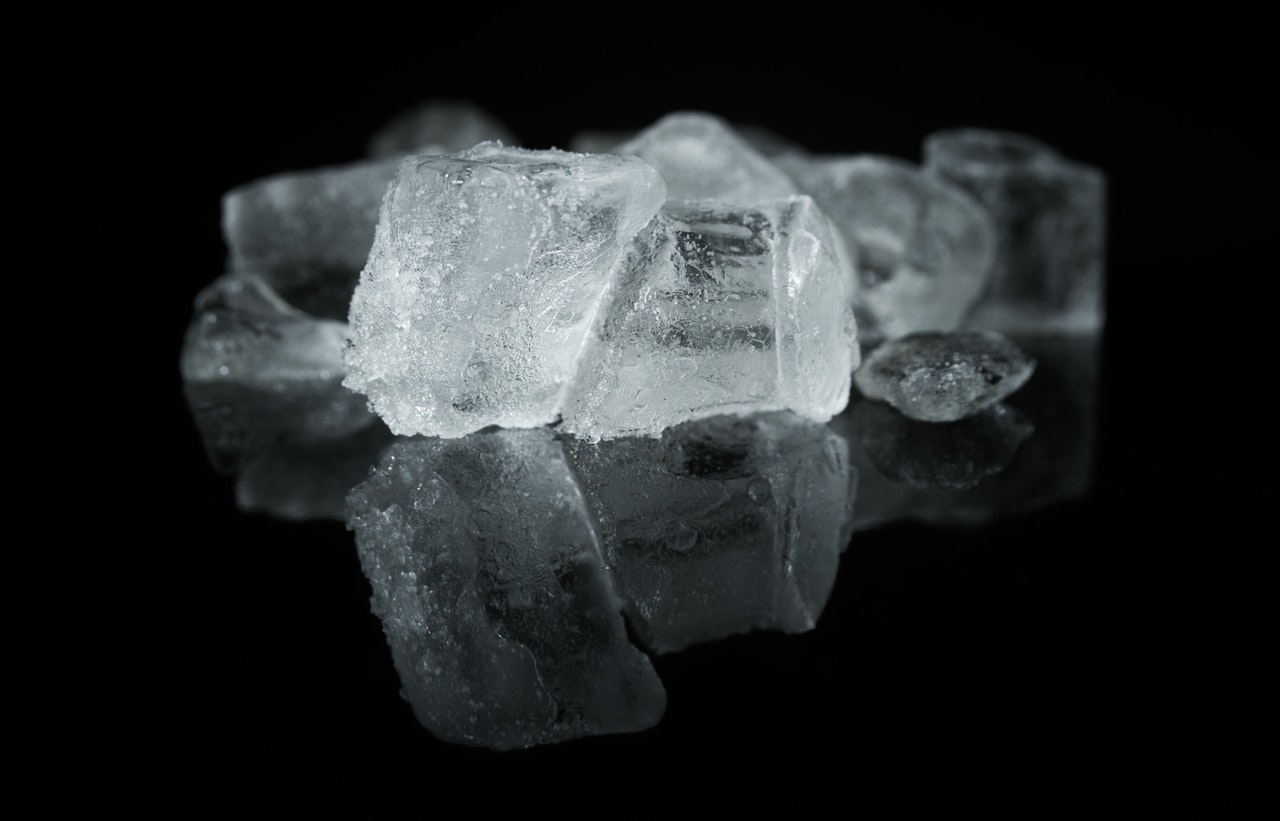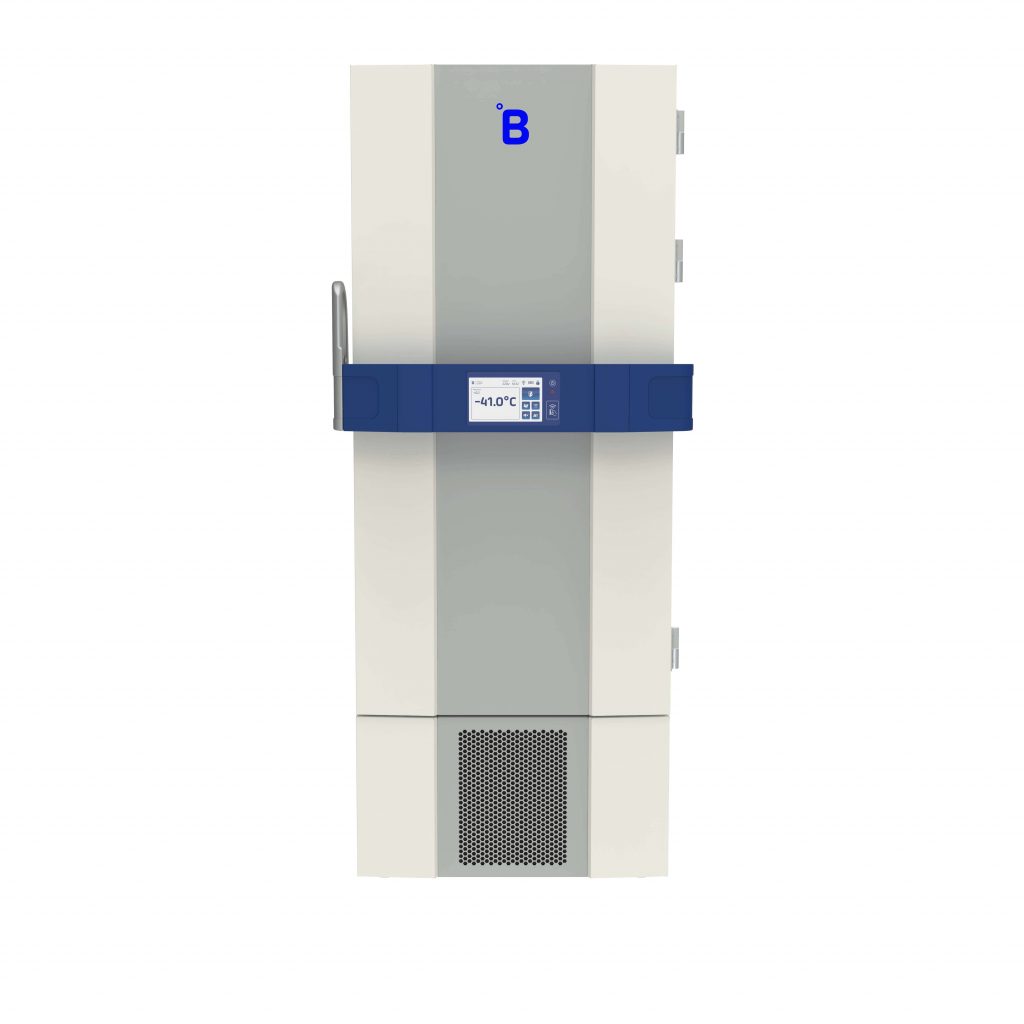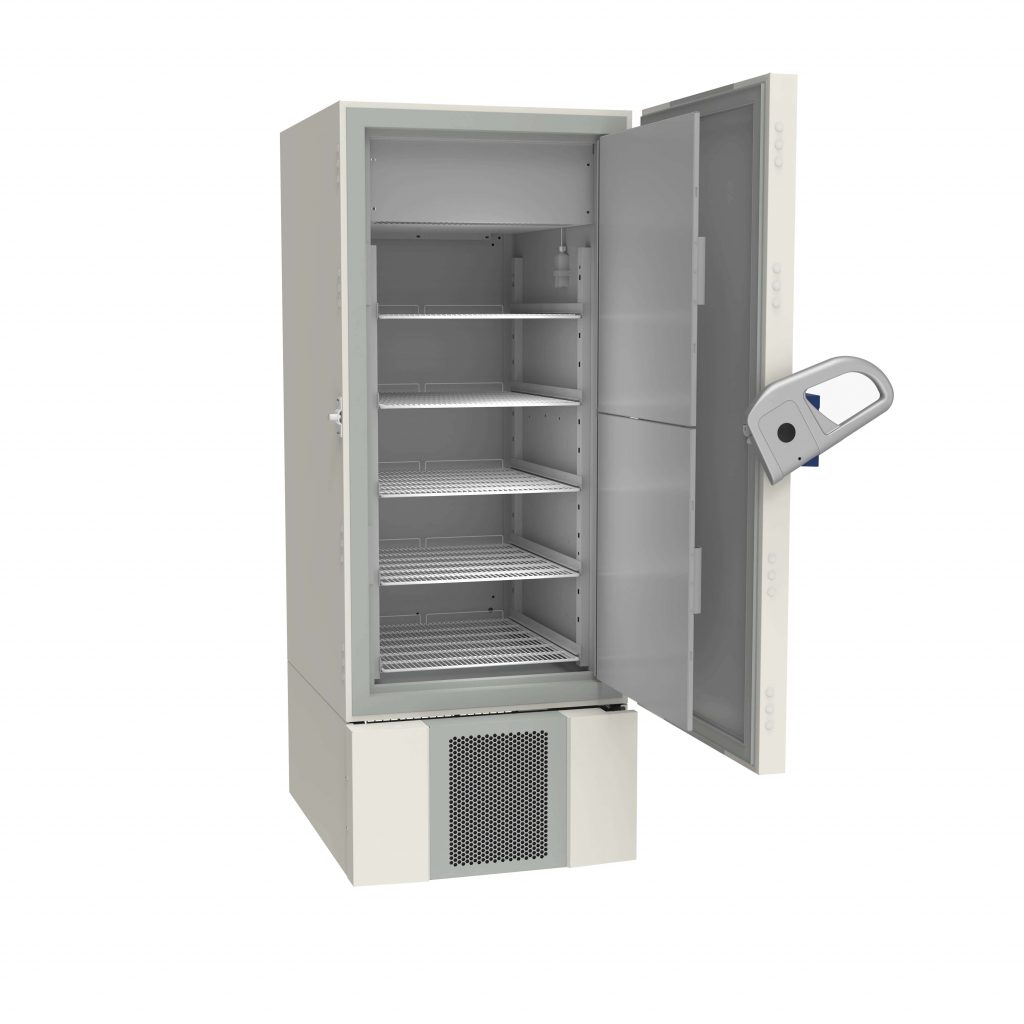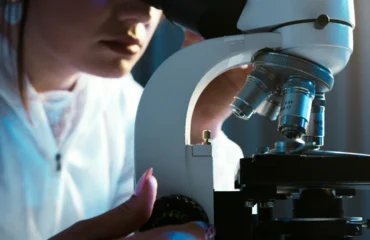In many laboratories, refrigeration equipment is vital to perform clinical and fundamental research. Basically, refrigeration equipment is used for transporting heat out of one place into another place, which a process that can be performed in numerous ways. The second law of thermodynamics provides that without any work done on the system, heat spontaneously flows from an object of higher temperature to an object of lower temperature.
Therefore, one of the easiest ways to cool something is by simply bringing it into contact with something colder to transfer the heat into, such as an ice bath when you cool a bottle of beer. Another way is evaporative cooling, when the heat is transferred into an evaporating substance. Examples are cooling with sublimating dry ice (solid carbon dioxide), or the sweating process to cool the human body where heat is carried away through the evaporation of water droplets on the skin.

Because heat can’t spontaneously flow from cold locations to hotter places, some external work needs to be performed to realise this. In refrigeration equipment this work is performed through cyclic refrigeration, where work is done repeatedly in refrigeration cycles. In each cycle, heat is transported from inside of the unit to the outside using processes such as condensation and evaporation. There are many different types of refrigeration equipment, and it depends a lot on the reason which types may be most suitable. It also depends on how much it needs to cool, from samples that need to be stored around or below 0°C or to cool much further to around −200 °C, for example to manufacture liquid nitrogen.
Refrigration equipment in research
One important reason to cool materials is to change their physical properties. As a pioneer in cooling substances, the Dutch Nobel-Prize-winning scientist Heike Kamerlingh Onnes devised an refrigeration instrument to cool helium all the way down until it becomes liquid. He used this device to study the properties of Helium in its liquid form, but also to used the liquid Helium to cool other materials and investigate their characteristics.
One of the most important discoveries of Heike Kamerling Onnes was that the electrical resistance of mercury vanished at temperatures as low as a few degrees above the lowest possible temperature of 0 degrees Kelvin (-271.15 °C). This phenomenon is now known as superconductivity and can also be found in other materials. For example, highly cooled superconductive materials can be used for powerful magnets.
Because superconducting magnets exhibit zero electrical resistance they do not generate heat, which is makes it possible to use them in techniques such as Nuclear Magnetic Resonance spectroscopy to characterise the chemical structure of compounds. For this, the magnets are often cooled with liquid nitrogen or liquid helium. Superconducting magnets are also used in particle accelerators such as those for CERN and many other applications such as MRI scanners and mass spectrometers.
In extreme cases, substances can be cooled so extremely that their temperature actually approaches 0 degrees Kelvin. Although this example is mostly of interest to investigate fundamental principles of physics on a small scale, there are actual larger-scale research instruments that need extremely low temperatures themselves to function, such as the MiniGRAIL detector which is designed to act as an antenna to detect gravitational waves mentioned in the video above.
Use of refrigeration equipment for storage
Besides their importance in research instrumentation applications, one of the most important function of refrigerators and freezers in modern laboratories is to store and conserve sensitive substances such as chemical, biological and medical samples. To cater this market, suppliers are continuously improving their own laboratory cooling systems and often focus on specific models and applications. Lab refrigerators are typically much more advanced and have to adhere to higher standards than devices for residential use. Often, they include additional options and capabilities to deal with outages and sudden temperature changes.
The most suitable type of freezers and refrigerator depend on the type of samples that need be stored. There are several parameters that can be important, first of which is the temperature range in which they operate. Biomedical refrigerators and freezers are essential to preserve a range of biological materials, including blood plasma, cell cultures, biological reagents, vaccines, medication. Labs use plasma freezers to store vaccines, whole blood, and plasma products in a temperature range between -30°C and -40°C. Blood component products or the whole blood are stored in blood bank refrigerators.
Particularly for long-term storage of the most sensitive materials, refrigerators can achieve and maintaining extremely low temperatures down to about -80 °C. Many biological materials and microorganisms require to be kept at such low temperatures to slow degradation. Often glycerol is added to suspensions with bacteria and cells to prevent the formation of ice crystals that can damage the cell membranes during the freezing process.
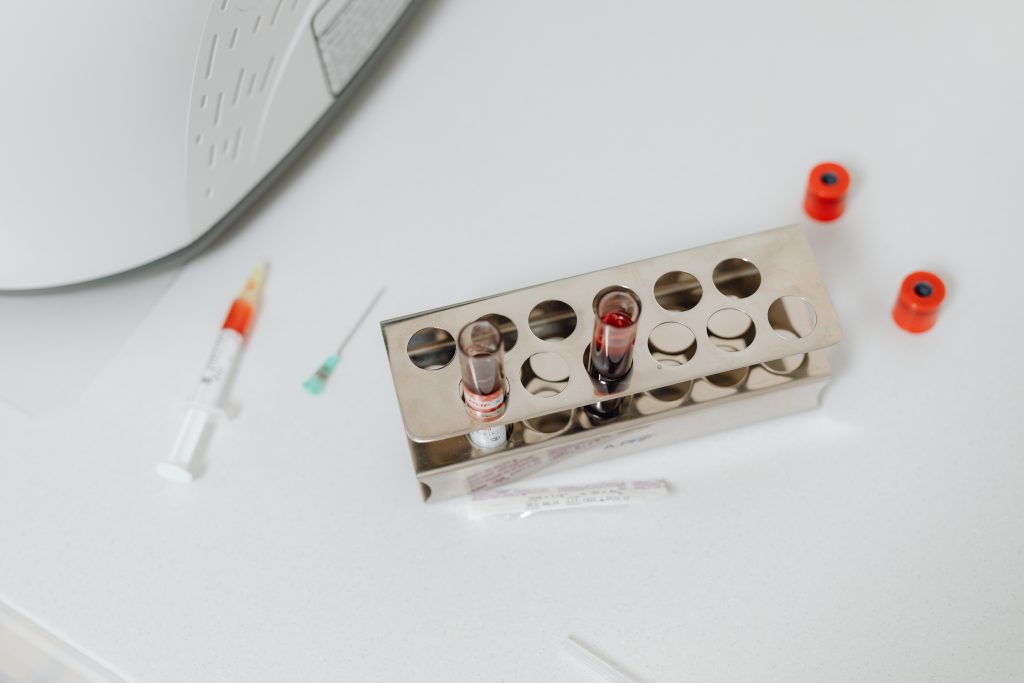
Shapes and sizes
Laboratory general-use refrigerators come in many different shapes and sizes. Some are small enough to fit under a bench or table, others are designed to sit on top of them while some full-size models are meters in width and height and can even comprise a whole room. Although smaller models often look similar to domestic fridges, they differ in that they optimized for clinical and medical laboratories to secure biological samples and other specimens.

The amount of room in the lab is a primary factor to be considered when selecting cooling equipment. Laboratory freezers come in various shapes and sizes, including under-counter, freestanding, double-wide, and chest freezer versions. While it is simpler to locate samples inside upright freezers which have a smaller ecological footprint, chest freezers retain cold air better and open and close more quickly.
When selecting a laboratory refrigerator or freezer, a general rule is to always make a reasonable assessment of how much storage space you need for your samples. Refrigerators typically operate best when between 30% and 80% full. Loading too much content may prevent proper air circulation and cold and hot patches that could harm the stored items. It is often advisable to use stand-alone freezers or refrigerators. It can be an advantage if the drawers are detachable for cleaning.
To get the best efficiency out of your compressor it is generally advised to place your cooling equipment sufficiently far from the wall so that the heat that is generated by the refrigerator can easily escape. Moreover, regular maintenance, including defrosting, vacuuming vents, and changing air filters, can prolong the unit’s useful life.
In some cases, special analysis techniques and instruments require cooling during their operation. For example, chromatography is used in a hospital or biotechnology laboratory to separate substances that are sensitive to heat. For such cases, chromatography refrigerators provide the possibility to work under precisely controlled and stable temperatures. A fan-forced refrigeration system ensures temperature uniformity while double-glazed doors make it simple to see the chromatography equipment while in use.
Temperature stability and monitoring
One of a laboratory freezer’s most crucial qualities is temperature stability. Regularly opening its doors introduces ambient air into the fridge, which can cause temperature spikes. Likewise, introducing new warmer samples or bottles can cause local hot spots. Part of this is alleviated by proper air circulation inside the fridge to quickly carry the heat away. Another way to reduce fluctuations is by keeping the freezer well-stocked at all times. Water bottles and frozen coolant packs can act as heat sinks and provide additional stabilisation of the temperature.
To help protect contents from ambient temperature when the door is opened, some vaccine refrigerators are constructed with inside drawers with solid fronts. The top and bottom parts of these drawers can have a wire-like structure that is partially open or with extra room at the back to allow for proper air circulation. Using such bins or baskets can also guarantee a better organisation of the contents while providing for a sufficient airflow within refrigerators.
When it comes to refrigeration, the thermometer used to measure temperature must be assessed thoroughly. This is particularly true when equipment is used storing highly sensitive vaccines that need be kept at low temperatures to remain stable. Wireless monitoring systems are now becoming the standard for ultra low temperature freezers (ULT freezers), blood bank refrigerators, and plasma freezers. These systems maintain the integrity of lab samples by continuously monitoring vital parameters such as the temperature, CO2 concentration, and relative humidity around-the-clock. These monitoring systems inform pre-assigned employees in real time in the event of a lab mechanical or electrical failure that may jeopardize biological samples’ integrity.
Internal device sensors often measure the internal air temperature inside a refrigeration unit. As a result, the sensor will display erroneous temperature readings brought on by air movements (such as the opening and closing of a refrigerator door) that would not accurately reflect the temperature of the individual vaccines. To avoid this it can be recommendable to use a glycol temperature probe. This probe is emerged in glycol that acts as a buffer to prevent false readings because of rapid air temperature fluctuations. Always ensure with the supplier that the thermometer is calibrated by an accredited laboratory and provides a certificate of traceability.
Safety Precautions
Safety considerations should be carefully considered when purchasing refrigeration equipment of any kind. Laboratories and medical facilities often store combustible and hazardous materials that can ferociously ignite and endanger the lives of people working around them. Besides these dangers, the loss of critical data and studies is inevitable in such an event. Sparks from a fan, compressor or internal lights can interact with flammable material stored within.
Explosion-proof refrigerators are designed to hold heat-sensitive and potentially explosive liquids and dangerous chemicals and are created such that compartments are spark and explosion-proof. Such refrigerators lack certain electrical components to prevent fire brought on by sparks in the storage compartment and to make them safe to use with flammable materials. Compartments should be fully insulated, and internal lights should be covered. Routine maintenance should be conducted at appropriate intervals to ensure safety and efficiency.
Besides flammable and explosive materials that require cooling, there may be other important factors such as toxicity or other hazardous physical or chemical properties. Each situation and application may require its own specific refrigeration equipment to provide a safe storage situation. It is generally advisable to consult with experts to discuss your situation.
Outlook
Refrigeration equipment is used advanced instrumentation for scientific research and is vital to store materials and samples in life sciences and clinical and medical laboratories. Although this article is too short to give a complete overview of all applications and considerations, hopefully is has shown some of the applications of modern refrigeration techniques and equipment. It may also provide some pointers that will help you navigate through optimum choices. Purpose, space and stability are key, so before purchasing any cooling equipment always ensure if it will provide sufficient room for storage yet at the same time fit well within your laboratory. Save money and maintenance costs by cleaning your equipment regularly and by providing ample ventilation.
For labs that are trying to save on costs, it may be well worth to consider second-hand equipment. The relatively low price of used fridges and freezers can be hugely advantageous in times where businesses try to save costs while supply chain issues are rampant and scarcity of raw materials is driving up the costs of new equipment.
Besides the lower price, also delivery times of used equipment are often lower than those for similar items that are new. Sometimes equipment can even be rented for the time that it is needed. We have learned that after the last COVID-wave of the recent pandemic, some manufacturers of new refrigeration equipment were focusing on producing and providing cooling equipment for the reopening catering industry because of the sudden high demand for fridges and freezers to store food and beverages. As this in turn lead to a temporary shortage of medical-grade refrigerators, some facilities made use of the option to rent used fridges to store new batches of vaccines.
Whether it is new or used refrigeration equipment you’re after, it is important to chose a trusted supplier to process your order and delivery and provide guarantees of installation, quality and maintenance. QuestPair offers a platform for suppliers, manufacturers and resellers to showcase their refrigeration equipment and other instruments to reach their public of research and industry professionals.

